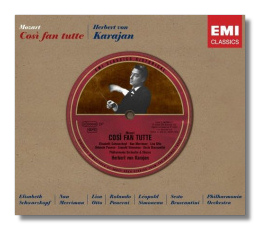
The Internet's Premier Classical Music Source
Related Links
- Mozart Reviews
- Latest Reviews
- More Reviews
-
By Composer
-
Collections
DVD & Blu-ray
Books
Concert Reviews
Articles/Interviews
Software
Audio
Search Amazon
Recommended Links
Site News
 CD Review
CD Review
Wolfgang Mozart

Così fan tutte, K 588
- Elisabeth Schwarzkopf (Fiordiligi)
- Nan Merriman (Dorabella)
- Lisa Otto (Despina)
- Léopold Simoneau (Ferrando)
- Rolando Panerai (Guglielmo)
- Sesto Bruscantini (Don Alfonso)
Philharmonia Orchestra & Chorus/Herbert von Karajan
EMI Classics 336789-2 ADD mono 3CDs: 63:44, 58:55, 38:15
Mozart's acid comedy about fidelity in love (or the lack thereof) rarely has had it so good. This recording, which dates from 1954, has seldom been out of the catalog, and it is generous of EMI to have reissued it at a budget price. This is a re-release of the digital remastering prepared in 1999 for the "Great Recordings of the Century" series; the only thing that has changed is the packaging. Instead of a full booklet containing texts and translations, we get Richard Osborne's essay, and a synopsis of the opera's action keyed to the various tracking points. Listeners in need of the libretto and translations are directed to EMI's website. Of course this will be unnecessary if you already have another Così in your collection. Most listeners will not want a 50-year-old monaural recording as their first Così, anyway. Nevertheless, they could hardly find a better one.
In some ways, the excellence of this recording is a little surprising. Karajan had conducted the score just once before, in 1937. After making this recording, he never returned to it. Also, this was Schwarzkopf's first Fiordiligi. Still, they immediately settle into their tasks with confidence. In fact, the mannerisms that can limit one's enjoyment of Schwarzkopf's work are absent here; it's almost as if the less she thought about what she was singing, the more natural she sounded. She sails through Fiordiligi's music with coolly radiant assurance and a flawless technique; the perils of "Come scoglio," for example, are fearlessly conquered. As her sister, Nan Merriman provides excellent contrast, and her performance of "Smanie implacabili" shows that she is every bit Schwarzkopf's equal, in terms of technical mastery. The dialogues between the two sisters crackle with seemingly natural spontaneity. That's true for all the dialogues in this recording, however.
As their hapless swains, Simoneau and Panerai are very much in the same league. Simoneau's "Un'aura amorosa" is one of the most melting and refined on discs – here's a Ferrando who is a credible lover. (No wonder Don Alfonso wins his bet.) His ability to move between different dynamic levels without changing the quality of his tone is astonishing. Panerai's Guglielmo, like Merriman's Dorabella, is crustier, but without any loss of refinement. His voice, always so full of personality, makes Guglielmo's character come alive.
Bruscantini's Don Alfonso clearly has everything under control here; he never even raises his voice. The result is a characterization that is even more manipulative than usual because it is so blithe. As Despina, Lisa Otto is like a cute teenager. She gets a little carried away with her doctorly and lawyerly accents in the two finales, but it's all in good fun.
Karajan conducts feelingly throughout, with perfectly judged tempos and a sympathetic feel for the score's ebb and flow. He cuts less of the score than most of his contemporaries did. (For example, both "Tradito, schernito" and "È amore un ladroncello" are retained.) The stars of the Philharmonia make their presences felt in the numerous wind solos. Only the chorus seems a little perfunctory.
The monaural sound is clear and very close, accenting the impression of dramatic intimacy. In other words, the sound is not modern, but it's not troublesome, either. The secco recitatives sound as if they were recorded in a different sonic environment, which would make sense, as two recording venues are listed.
There are many reasons why this recording has been around for more than half a century. Now it is cheaper than ever to learn firsthand what those reasons are.
Copyright © 2006, Raymond Tuttle




















